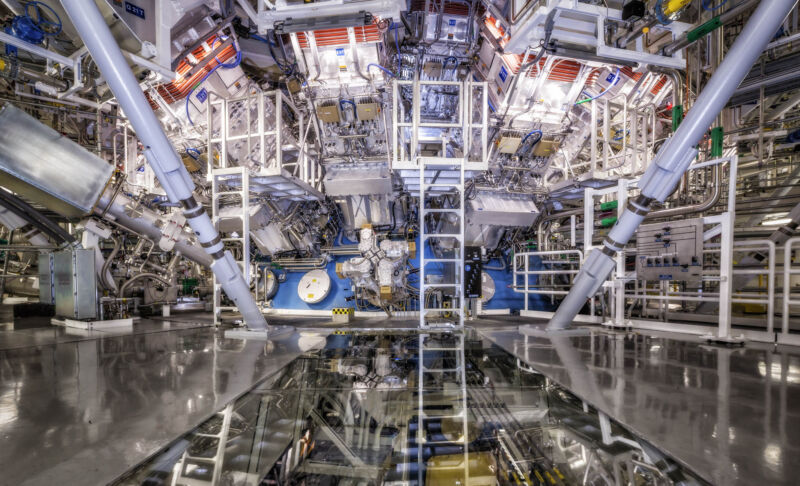On Monday, a paper was released that describes some confusing results from the National Ignition Facility, which uses a lot of very energetic lasers focused on a small target to begin a fusion reaction. Over the past few years, the facility has passed some key milestones, including ignition of fusion and creating what's termed a burning plasma.
Now, researchers have analyzed the properties of the plasma as it experiences these high-energy states. And to their surprise, they found that burning plasmas appear to behave differently from those that have experienced ignition. At the moment, there's no obvious explanation for the difference.
Ignition vs. burning
In the experiments, the material being used for fusion is a mix of tritium and deuterium, two heavier isotopes of hydrogen. These combine to produce a helium atom, leaving a spare neutron that's emitted; the energy of the fusion reaction is released in the form of a gamma ray.
The fusion process is triggered by a short, extremely intense burst of laser light that targets a small metallic cylinder. The metal emits intense X-rays, which vaporize the surface of a nearby pellet, creating an intense wave of heat and pressure on the pellet's interior, where the deuterium and tritium reside. These form a very high-energy plasma, setting the conditions for fusion.
If everything goes well, the energy imparted ignites the plasma, meaning that no additional energy is needed for the fusion reactions to continue for the tiny fraction of a second that passes before the whole thing blows apart. At even higher energies, the plasma reaches a state called burning, where the helium atoms that are forming carry so much energy that they can ignite the nearby plasma. This is considered critical because it means the rest of the energy (in the form of neutrons and gamma rays) can potentially be harvested to produce useful power.
While we have detailed models of the physics that goes on under these extreme conditions, we need to compare those models to what's going on inside the plasma. Unfortunately, given that both the plasma and the materials that formerly surrounded it are in the process of exploding, that's a significant challenge. To get a picture of what might be going on, researchers have turned to one of the products of the fusion reaction: the neutrons it emits, which can pass through the wreckage and be picked up by nearby detectors.
Taking a temperature
The physics of the fusion reaction produces neutrons with a specific energy. If fusion happened in a material where the atoms were stationary, all of the neutrons would come out with that energy. But obviously, the atomic nuclei in the plasma—the tritium and deuterium—are moving about violently. Depending on how they're moving relative to the detector, these ions may impart some additional energy to the neutrons, or subtract a bit.
This means that, instead of coming out as a sharp line at a specific energy, the neutrons come out at a range of energies that form a broad curve. The peak of that curve is related to the motion of the ions in the plasma, and thus the temperature of the plasma. Further details can be extracted from the shape of the curve.
Between the ignition point and the burning point, we seem to have an accurate understanding of how the temperature of the plasma relates to the velocity of the atoms in the plasma. The data from the neutrons lines up nicely with the curve that's calculated from our model predictions. Once the plasma switches over to burning, however, things no longer match. It's like the neutron data finds a completely different curve and follows along that instead.
So, what might explain that different curve? It's not that we have no idea; we have a bunch of them and no way to tell them apart. The team that analyzed these results suggests four possible explanations, including unexpected kinetics of individual particles in the plasma or a failure to account for details in the behavior of the bulk plasma. Alternatively, it could be that the burning plasma extends over a different area, or lasts a different amount of time, than we'd predict.
In any case, as the authors state, "Understanding the cause of this departure from hydrodynamic behavior could be important for achieving robust and reproducible ignition."
Nature Physics, 2022. DOI: 10.1038/s41567-022-01809-3 (About DOIs).



3175x175(CURRENT).thumb.jpg.b05acc060982b36f5891ba728e6d953c.jpg)

Recommended Comments
There are no comments to display.
Join the conversation
You can post now and register later. If you have an account, sign in now to post with your account.
Note: Your post will require moderator approval before it will be visible.